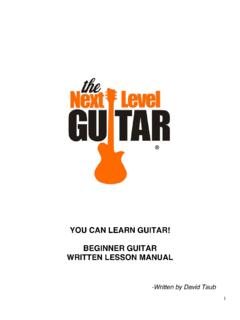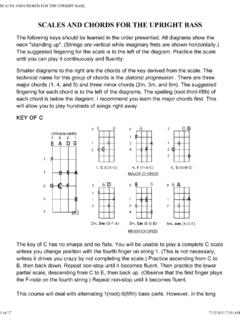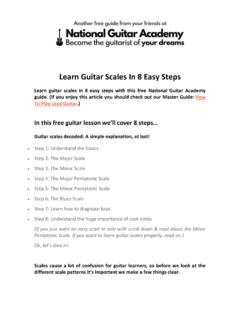Transcription of Minor Pentatonic - The Basic Box Shape
1 Minor Pentatonic - The Basic Box ShapeMinor Pentatonic Basic #1 Box143311144113root notes #fingering to utilizePentatonic scales are the most commonly used scales in most genres of music. You will want to get very comfortable with them. Often they are the first scales students learn on their lead guitar is Latin for five. Like a penta-gram has five sides and a penta-gon has five sides, Pentatonic scales are constructed from five notes. The Minor Pentatonic scale is constructed from five notes of the natural Minor scale. The intervals in Minor Pentatonic are root or 1, b3rd, 4th, 5th, and b7th. The scale illustrated on the right is the most common Basic box position. This scale has its low root played with the first finger on the low E string. The root notes are illustrated with black ovals and the numbers inside the circles indicate the fingering to be utilized when playing this scale.
2 At first try utilizing one finger per are going to build upon this scale in coming lessons. Eventually you will need to learn this scale in all positions all over the neck , and in all keys. Start with this Basic box, then on to the Expanded I, and eventually all five box shapes as illustrated in the coming pages of this the scale utilizing the fingerings illustrated. Sound each note clean, with no string buzzes or overtones. As you move through the scale make a mental note of when you hit the three root key signature is determined by which root note is played. If you play this scale starting at the third fret on the low E string it is a G Minor Pentatonic scale consisting of notes G, Bb, C, D, and F. If you were to play this scale starting on the 8th fret, it would be a C Minor Pentatonic scale consisting of notes C, Eb, F, G, and like moveable bar chords this scale can be moved up and down the guitar neck and the root note will determine the key you are playing .
3 Practice the scale in all keys and apply it over the jam tracks as per the video lessons and jam track application scale will form the building block of many concepts in the coming lessons. You want to be very familiar with this scale pattern, but do not rely on it exclusively. Next we will be expanding this scale across the fretboard. This will produce a more fluid sounding scale that you can move laterally across the neck combining multiple box positions. Get ready to rock!Copyright 2016 Next Level Guitar Inc. All rights reserved. Unauthorized duplicationor distribution strictly Bending in Minor Pentatonic Bending strings is one of the most expressive things you can do on the guitar. You will want to get very proficient and accurate with string bending, it s an bending strings, it is imperative that you are bending notes in pitch to the proper target note. You don t want to over bend or under bend notes, as they will then sound sharp or flat.
4 Practice bending strings and then check the pitch by sounding the note you are attempting to bend to, your target note. This is a good self-check to ensure you are bending in can also practice string bending in pitch by plugging into an electronic tuner that has a needle and watching the needle as you bend a note and ultimately see it hit pitch. Keep doing it over and over until you feel the bend string tension-wise, as well as hear the bend in pitch match to the target the box pattern scale illustrated on the right with a fifth fret low-E string root. That root note would make this an A Minor Pentatonic scale. Once you learn the string bends listed below, practice them using different shapes and in all keys. For now try the bends in A Minor Pentatonic using the Basic box b3rd to major 3rd bend. Bend the b3rd or C note a quarter to a half step to the major 3rd. This is a very cool bend as the b3rd is a very ambiguous note in this scale.
5 It sometimes will sound great as the b3rd but also as a major 3rd. This note has some play in it and you don t have to be exact with the bend. Play with it and you will soon be utilizing this bend all the Bend the 4th a half step to the blue note. Bend the D note 7th fret G string up one half step to the Eb note. This is a very popular blues Bend the 4th degree a whole step to the fifth. Bend the D note 7th fret G-string up one whole step to the E note. The 4th or D note can be bent either a whole or a half Bend the b7th a whole step up to the root. Bend the G note 8th fret B string up one whole step to the A root note. You can also bend the same note an octave lower at the G note at the 5th fret on the D string up one whole Unison bend. Use your 4th finger to bend the G note 8th fret B string a whole step to an A note while playing the A note 5th fret high E string with your 1st Unison bend. Use your 3rd finger to bend the D note 7th fret G string a whole step to an E note while playing the E note 5th fret B string with your 1st Bend the b3rd a full step to the 4th.
6 Bend the C note 8th fret high E string one whole step to the D Double stop bend. Bend two strings a half step each with your 3rd finger by barring across the 7th fret with one finger. Bend the D note 7th fret G string one half step while also bending the F# note 7th fret B string one half Double stop bend. Use your 3rd finger to bend the D note 7th fret G string a whole step while playing the G note on the B string 8th fret with your 4th and get creative with these string bending ideas. Remember to keep checking your bends to ensure you are bending in pitch. Minor Pentatonic Basic #1 Box Pattern143311144113 Copyright 2016 Next Level Guitar rights reserved. Unauthorized duplicationor distribution strictly prohibited. #1 Box143311144113root notes #fingering to utilizeThe five Minor Pentatonic box shapes illustrated below cover the entire guitar neck . These are must-know scales, especially for blues and rock. Take your time learning them, chip away a little each day.
7 As you move through each scale make a mental note of when you pass through a root note, which are illustrated in five positions are the architecture to build endless licks and runs. They also connect into longer expanded scales that you will learn in the coming pages. To avoid getting stuck in one position be sure to learn ALL the positions and practice them in different keys over the included jam tracks. These scale shapes are moveable and the key is determined by the low root note. For example, if you want to solo with Box #1 in G Minor Pentatonic use your first finger starting at the third fret on the low E-string and play the Shape . Third fret low-E string is an G note. That makes the scale an G Minor Pentatonic scale with the notes G, Bb, C, D, and F. To try another Pentatonic box in G Minor play box #3 using your 3rd finger at the 10th fret A-string. Fret ten on the A-string is a G note. You are playing the same five notes as in the above example, G, Bb, C, D, and F, just in a different position on the guitar neck .
8 Along with memorizing the scale shapes it is also critical to know what notes you are playing and how to apply these scales. Too often, guitarists memorize only shapes. Don t just learn scale shapes, take the time to also learn the notes and how to musically apply the scale, in the end it will make you a better critical element when learning scales is to not only memorize the scale but also learn it s application. Learn how to apply it in a musical context. over what chords, in what key. Start by memorizing and practicing the four applications for Minor Pentatonic . Practice these scales and apply them over the jam #5 Box113411324341 #2 Box #4 Box4332114411411 #3 Box11111433334 Minor Pentatonic - The Five Box ShapesCopyright 2016 Next Level Guitar Inc. All rights reserved. Unauthorized duplicationor distribution strictly notes #fingering to utilize Minor Pentatonic Expanded II Scale:(combines box shapes #3,#4,#5)11333111311313To play these expanded scales in G Minor first find the G play the expanded I scale in G Minor , start with your third finger on the 3rd fret of the low E-string and play the Shape .
9 Third fret low E-string is a G note. To play the expanded II scale in G Minor , start with your third finger on the 10th fret of the A-string and play the Shape . Tenth fret A-string is a G note. To locate these scales fast, find the low root note. The expanded I uses 3rd finger root on the low E-string and the expanded II uses 3rd finger root on the A-string. Find the root notes and blast away from there!Practice in all keys and over the jam tracks. Put on the tracks and just get lost in them!Let s build on the Minor Pentatonic scales that you learned in the previous lesson. We will expand the scale two frets in each direction combining three box shapes to double the playing area. These expanded scales will get you playing ACROSS the neck and eliminate the stuck in the box are still going to play the same five-note Pentatonic scale but these expanded scale produce a more fluid sound as opposed to staying in just one vertical box.
10 You certainly want to have all the box patterns in your playing arsenal, but these expanded scales open the pathways and lead guitar avenues. You will utilize these expanded scales all the time, they are below, are three box patterns encapsulated within each of the longer shapes. The expanded shapes are stretched two frets in each direction combining three adjacent boxes. The expanded I scale combines boxes 5, 1, and 2 while the expanded II scale combines boxes 3, 4, and 5. These expanded Pentatonic scales double the fret span of the single box patterns. Practice these expanded scales in different keys and add them to your playing arsenal. Just like the box patterns these expanded scales are moveable and the root note determines the key. Same principle applies to finding them in the proper key as with the individual box shapes. Minor Pentatonic - The Expanded ShapesMinor Pentatonic Expanded I Scale:(combines box shapes #5,#1,#2 )11313311332311 Copyright 2016 Next Level Guitar Inc.







